How Did the Wind Continue to Haras People in Asano Park
Total number of trees
1 Weeping Willow
1. Weeping Willow (Salix Babylonica) 14 Motomachi, Naka-ku, Hiroshima-shi
14 Motomachi, Naka-ku, Hiroshima-shi
Specie(s):Salix Babylonica
Distance from the hypocenter:370m
Location:On the west side of the Hiroshima City Youth Center, On the east bank of the Honkawa River


Among existing A-bombed trees, the weeping willow is closest to the hypocenter. Its trunk broke due to the A-bombing but sprouted later.
The Aioi Bridge, located near the tree, was the target of the bombing because it was uniquely T-shaped and therefore clearly visible from the air.
There are many cherry trees along the Honkawa River, and people enjoy cherry blossom viewing in spring.
Reference (Japanese): 被爆樹木リスト Weeping Willow
2 Kurogane Holly
2. Kurogane Holly (Ilex Rotunda) 5-15 Fukuromachi, Naka-ku, Hiroshima-shi
5-15 Fukuromachi, Naka-ku, Hiroshima-shi
Specie(s):Ilex Rotunda
Distance from the hypocenter:410m
Location:Rai Sanyo Historic Site Museum
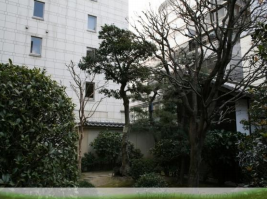

The kurogane holly was A-bombed in the former Sanyo Museum. The tree did not burn to the ground because it was behind the former Hiroshima Branch of the Bank of Japan, adjacent to the museum. However, the trunk of the A-bombed tree broke due to the bomb blast. Later, it sprouted and grew to the kurogane holly we see today.
The former Sanyo Museum was constructed in 1935 and destroyed by the A-bombing. After the war, the museum was repaired and used as a social education facility. In 1995, it was renovated and opened as the Rai Sanyo Historic Site Museum. (Inquiry: 082-298-5051)
Rai Sanyo (1781-1832), a scholar who wrote Nihon Gaishi on Japanese history, was born in Osaka but raised in Hiroshima. He was the eldest son of a scholar Rai Shunsui. Illegally leaving Hiroshima without permission in 1800, he was arrested and confined to his house for three years. (The house was at the same place as the former Sanyo Museum.) Furthermore, he was under a less severe arrest for another two years. He started writing Nihon Gaishi during the years. (It was completed in 182 and published after his death, becoming a bestseller afterwards.)
Reference 1 (Japanese): 被爆樹木リスト Kurogane Holly
Reference 2: Rai Sanyo Historic Site Museum
3 Weeping Willow
3. Weeping Willow (Salix Babylonica) 5 Motomachi, Naka-ku, Hiroshima-shi
5 Motomachi, Naka-ku, Hiroshima-shi
Specie(s):Salix Babylonica
Distance from the hypocenter:450m
Location:Hanover Garden, On the east side of the Hiroshima Children's Museum

There used to be many weeping willows around the place where this weeping willow is situated now. (It relocated to the current location after the A-bombing.) Some of the willows survived the A-bombing, but it is the only one that is still alive today.
The Hanover Garden, built in commemoration of the affiliation of Sister Cities between Hiroshima City and Hannover city in 1980, is a part of the Central Park located in the heart of Hiroshima city.
Regarding the Hiroshima Children's Museum, there are two floors of activities for kids to enjoy while learning about science, special workshops in Japanese, and public access to the attached library full of books for children.
Reference 1 (Japanese): 被爆樹木リスト Weeping Willow
Reference 2: Hannover Garden
Reference 3: Hiroshima Children's Museum
4 Camphor Tree
4. Camphor Tree (Cinnamomum Camphora) 7-24 Nakamachi, Naka-ku, Hiroshima-shi
7-24 Nakamachi, Naka-ku, Hiroshima-shi
Specie(s):Cinnamomum Camphora
Distance from the hypocenter:490m
Location:Shirakamisha Shrine

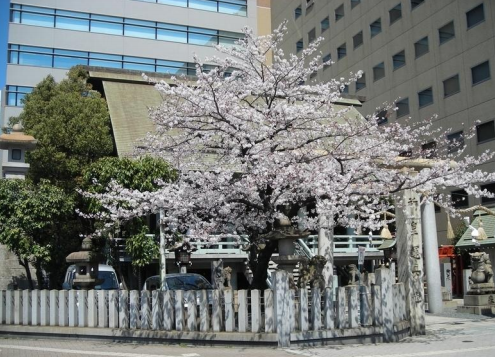
There are three A-bombed camphor trees in the shrine. Their aerial parts burned downed due to the bombing, but their roots survived and sprouted later.
The location of the shrine was the seafront about 500 years ago. For the sake of preventing shipwreck, a white paper (shira-kami in Japanese) was placed on a rock. The name of the shrine comes from that.
Reference (Japanese): 被爆樹木リスト Camphor Tree
5 Thorny Elaeagunus
5. Thorny Elaeagunus (Elaeagnus Pungens) 2-5-13 Honkawacho, Naka-ku, Hiroshima-shi
2-5-13 Honkawacho, Naka-ku, Hiroshima-shi
Specie(s):Elaeagnus Pungens
Distance from the hypocenter:520m
Location:Jodoshuseiju Temple


The aerial part of the thorny elaeagunus burned downed due to the A-bombing. However, its roots survived and sprouted later. The tree is the only thorny elaeagunus that was A-bombed and still alive today.
In the early 16th century, the Jodoshuseiju Temple was constructed in Yoshida. It relocated to its current location in 1590. The temple remained the biggest in Hiroshima until it burned downed due to the A-bombing.
Reference (Japanese): 被爆樹木リスト Thorny Elaeagunus
6 Japanese Persimmon and Others
6. Japanese Persimmon and Others (Diospyros Kaki, etc.) 3 Komachi, Naka-ku, Hiroshima-shi
3 Komachi, Naka-ku, Hiroshima-shi
Specie(s):Diospyros Kaki, etc.
Distance from the hypocenter:530m
Location:Along Peace Boulevard, Adjacent to Shirakamisha Shrine

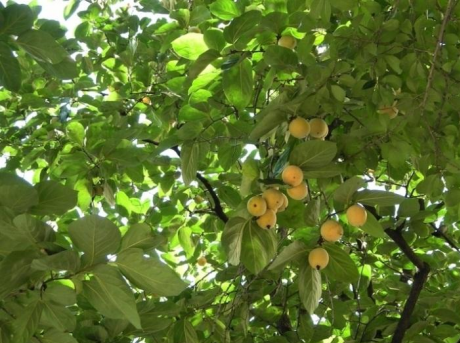
In addition to the Japanese persimmon, there are also 11 A-bombed trees: two Japanese hackberries, three muku trees, five kurogane hollies, and a Japanese bead tree.
The Japanese persimmon is the only A-bombed persimmon that is still alive today. Also, only the Japanese bead tree we see today was A-bombed and is still alive.
Reportedly, the Japanese hackberries were one huge tree originally but broke down due to the A-bombing. Afterwards, two stumps sprouted ad grew separately. However, it has gradually turned out that they are genetically different from one another. Researchers are studying whether they are genetically identical or not.
The aerial parts of the muku trees and the kurogane hollies burned down due to the A-bombing, but their roots survived and sprouted later.
Reference 1 (Japanese): 被爆樹木リスト Japanese Hackberry
Reference 2 (Japanese): 被爆樹木リスト Muku Tree
Reference 3 (Japanese): 被爆樹木リスト Kurogane Holly
Reference 4 (Japanese): 被爆樹木リスト Japanese Persimmon
Reference 5 (Japanese): 被爆樹木リスト Japanese Bead Tree
7 Eucalyptus and Giant Pussy Willow
7. Eucalyptus and Giant Pussy Willow (Eucalyptus Melliodora, Salix Chaenomeloides) 21 Motomachi, Naka-ku, Hiroshima-shi
21 Motomachi, Naka-ku, Hiroshima-shi
Specie(s):Eucalyptus Melliodora, Salix Chaenomeloides
Distance from the hypocenter:740m
Location:Hiroshima Castle
The eucalyptus broke due to a typhoon in 1971 but sprouted later. It is the only A-bombed eucalyptus that is still alive today. People call the tree maruba-yanagi because it has round leaves. There is a hollow inside the trunk of the willow. The willow is the only A-bombed maruha-yanagi that is still alive today.
Hiroshima Castle was established in 1589 by Mori Terumoto (1553-1625), who was defeated in the War of Sekigahara in 1600 and consequently ordered to leave Hiroshima for today's Yamaguchi Prefecture. After his departure, Fukushima Masanori (1561-1624) became the lord of Hiroshima, where he settled around 1600. However, he had to leave Hiroshima 19 years later because he repaired the castle's stone walls destroyed by a typhoon without permission. After Fukushima's departure, Asano Nagaakira (1586-1632) became the lord of Hiroshima. The ruling of the Asano family in Hiroshima continued until 1871. The primary main function of the second compound called Ninomaru, constructed in around 1600, is to protect Honmaru, the innermost area of the castle. The wooden bridge leading to Ninomaru and the gate called omote gomon, which means front gate or main gate, was reconstructed in 1991.
Reference 1 (Japanese): 被爆樹木リスト Eucalyptus
Reference 2 (Japanese): 被爆樹木リスト Giant Pussy Willow
Reference 3 (Japanese): 広島城 Hiroshima Castle
8 Catalpa
8. Catalpa (Catalpa Bignonioides) 15 Motomachi, Naka-ku, Hiroshima-shi
15 Motomachi, Naka-ku, Hiroshima-shi
Specie(s):Catalpa Bignonioides
Distance from the hypocenter:760m
Location:Central Park (Chuo Koen)


There are many trees in the park, and it is pleasant to walk along the streams running through it. The waters coming from the Ota River goes through the stream in the north part of the park into the Hiroshima Castle's moat. The waters coming out of the moat drain into the stream in the south part of the park. After that, the waters return to the Ota River. In this way, the water in the castle moat is kept clean. The tall buildings on the north side of the park are the Municipal Motomachi High-Rise Apartment, a public complex built in the 1970s. The Chinese garden Yuhua Garden in the southwest corner of the park was created in 1991 to commemorate the sister-city agreement between Hiroshima and Chongqing, China.
Referece (Japaese):『都市の都市の復興-広島被爆 40 年史-』広島市 1985 年
9 Japanese Sago Palm
9. Japanese Sago Palm (Cycas Revoluta) 3-10-4 Otemachi, Naka-ku, Hiroshima-shi
3-10-4 Otemachi, Naka-ku, Hiroshima-shi
Specie(s):Cycas Revoluta
Distance from the hypocenter:800m
Location:Choonji Temple


The aerial parts of the Japanese sago palms burned down due to the A-bombing, but their roots sprouted later. They were one stump of palms but separately transplanted to the current location. The grave of a famous novelist, Suzuki Miekichi (1882-1936), is located here.
Reference (Japanese): 被爆樹木リスト Japanese Sago Palm
10 Suffruticosa Paeony and Shirodamo
10. Suffruticosa Paeony and Shirodamo (Paeonia × Suffruticosa, Neolitsea Sericea) 3-13-11 Otemachi, Naka-ku, Hiroshima-shi
3-13-11 Otemachi, Naka-ku, Hiroshima-shi
Specie(s):Paeonia × Suffruticosa, Neolitsea Sericea
Distance from the hypocenter:890m
Location:Honkyoji Temple


The aerial parts of the suffruticosa paeony and shirodamo burned down due to the A-bombing, but their roots sprouted and separately relocated to multiple places.
Reference (Japanese): 被爆樹木リスト Suffruticosa Paeony
11 Kurogane Holly
11. Kurogane Holly (Ilex Rotunda) 21 Motomachi, Naka-ku, Hiroshima-shi
21 Motomachi, Naka-ku, Hiroshima-shi
Specie(s):Ilex Rotunda
Distance from the hypocenter:910m
Location:Hiroshima Castle


There are three A-bombed kurogane hollies there. They were in front of the building used as the Imperial Headquarters during the Sino-Japanese War (1894-95). The building was destroyed by the A-bombing, only leaving its foundations. The castle tower was also destroyed by bombing but rebuilt into a history museum in 1958.
There is a shrine called Gokoku Shrine near the hollies. The shrine relocated to its current location in 1956. Next to the shrine was a semi-underground facility used by the Chugoku Regional Military Headquarters during WWII as an air-defense communication room. Mobilized students from the Hijiyama Girls' High School worked here during the war, passing along information on air-raid warnings to government facilities and media.
Reference (Japanese): 被爆樹木リスト Kurogane Holly
12 Kurogane Holly
12. Kurogane Holly (Ilex Rotunda) 9-37 Komachi, Naka-ku, Hiroshima-shi
9-37 Komachi, Naka-ku, Hiroshima-shi
Specie(s):Ilex Rotunda
Distance from the hypocenter:940m
Location:Kinryuji Temple
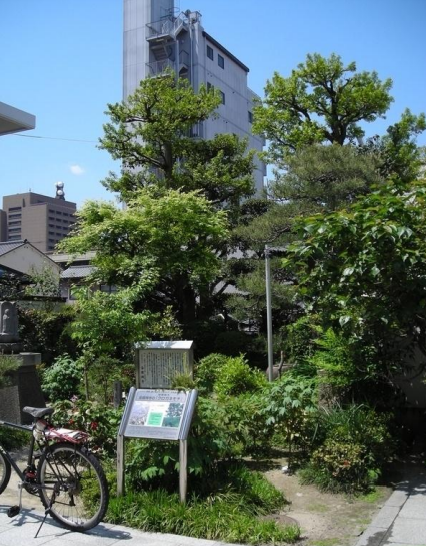
There are two A-bombed kurogane hollies in the Kinryuji Temple. Their trunks lean towards the hypocenter due to the A-bombing.
The temple was built in 1632 but burned down due to the A-bombing. It was reconstructed later.
Reference (Japanese): 被爆樹木リスト Kurogane Holly
13 Camphor Tree
13. Camphor Tree (Cinnamomum Camphora) 16 Motomachi, Naka-ku, Hiroshima-shi
16 Motomachi, Naka-ku, Hiroshima-shi
Specie(s):Cinnamomum Camphora
Distance from the hypocenter:990m
Location:In the parking lot on the southwest side of Municipal Motomachi High-Rise Apartment


The tree's trunk leans towards the hypocenter and has a scar made by the blaze after the A-bombing.
There is a promenade on the riverbank near the tree. There were so-called A-bomb slums around the area after the war. Town of Evening Calm, Country of Cherry Blossoms by Kono Fumiyo is a beautiful manga that tells a story of this area after the war.
Reference (Japanese): 被爆樹木リスト Camphor Tree
14 Yoshino Cherry
14. Yoshino Cherry (Cerasus × Edoensis 'Somei-Yoshino') 1-6-34 Kokutaijimachi, Naka-ku, Hiroshima-shi
1-6-34 Kokutaijimachi, Naka-ku, Hiroshima-shi
Specie(s):Cerasus × Edoensis 'Somei-Yoshino'
Distance from the hypocenter:1050m
Location:Hiroshima City Hall
Located in front of the city hall. There are three A-bombed cherry trees--two on the north and one on the south sides. The present city hall was built in 1985 at the site of the former city hall (built 1928; dismantled 1985). The former city hall was also a concrete building, but everything inside was burned. It was used as a temporary first-aid station after the atomic bombing, and a part of the basement has been left as a small museum. Masuda Kiyoshi (1888-1977) who designed the former city hall also designed Taishoya kimono shop, now the city's "Rest House," where a tourist information office is located. It was built in 1929 and is one of the A-bombed buildings in Hiroshima. He also designed Honkawa Elementary School, built in 1928, a part of which has been left as a museum.
Reference 1 (Japanese):『被爆50周年 ヒロシマの被爆建造物は語る―未来への記録』 広島市 1996年
Reference 2 (Japanese):『近代日本の建築活動の地域性―広島の近代建築とその設計者たち』 李明・石丸紀興 渓水社 2008年
15 Camphor Tree
15. Camphor Tree (Cinnamomum Camphora) 20 Motomachi, Naka-ku, Hiroshima-shi
20 Motomachi, Naka-ku, Hiroshima-shi
Specie(s):Cinnamomum Camphora
Distance from the hypocenter:1090m
Location:Motomachi Police Box

Located at the Motomachi high-rise apartment buildings near the police box. At about 30 meters, this is the tallest of all A-bomb trees. These high-rises are municipal and prefectural apartment buildings built in the 1970s, designed by Otaka Masato (1923-2010), whose teacher, Maekawa Kunio (1905-1986) was a student of Le Corbusier. You can see a strong influence of Le Corbusier on these apartment buildings. Looking east from the police box, there is a very modern building, located to the north of the castle. It is Motomachi Senior High School. The school was relocated from Nakahiro to this place in 1947, after losing 369 teachers and students in the atomic bombing. The present buildings of the high school were built in 1998 and 1999, designed by Hara Hiroshi (1936-), who also designed Kyoto Station. This is the only public school in Hiroshima that has escalators for students. The Hiroshima Army Cadet School was located at the site of the high school until the end of the war.
Reference 1 (Japanase):『被爆50周年 図説戦後広島市史 街と暮らしの50年』広島市 1996年
Reference 2 (Japanese):『被爆 50 周年 ヒロシマの被爆建造物は語る―未来への記録』 広島市 1996年
Reference 3 (Japanese)
16 Crape Myrtle
16. Crape Myrtle (Lagerstroemia Indica) 3-11 Teramachi, Naka-ku, Hiroshima-shi
3-11 Teramachi, Naka-ku, Hiroshima-shi
Specie(s):Lagerstroemia Indica
Distance from the hypocenter:1100m
Location:Zenshoji Temple


Red blossoms bloom in summer. The tree was moved from the west side of the precincts near the streetcar tracks to the present location when the temple was renovated. In the early 17th century, lord Fukushima Masanori gathered many temples of Jodo Shinshu (True Pure Land School) in this area to protect the castle. Thus this area is called "Teramachi," meaning "temple town." As these temples were protected by the succeeding lords of Hiroshima, Jodo Shinshu prospered in this province.
The tree is temporarily at the other location.
17 Camphor Tree
17. Camphor Tree (Cinnamomum Camphora) 21 Motomachi, Naka-ku, Hiroshima-shi
21 Motomachi, Naka-ku, Hiroshima-shi
Specie(s):Cinnamomum Camphora
Distance from the hypocenter:1120m
Location:On the north side of Hiroshima Castle, On the northwest side of RCC Broadcasting Co.,Ltd.


Located outside the moat of the castle, at the northeast corner, near Hakushima Elementary School. The tree is bent due to the atomic bombing. The Hiroshima Army Cadet School was located around here to the north of the castle, and remains of the gate's stone poles stand near the tree. Hakushima Elementary School and Motomachi Senior High School are now located on the former site of the Cadet School. The elementary school was originally located a few hundred meters to the northeast of today's location. Hundreds of students as well as the principal died in the atomic bombing. In October 1945, the elementary school resumed teaching at a temporary school building at the present location.
Reference (Japanese):『被爆50周年 ヒロシマの被爆建造物は語る―未来への記録』 広島市 1996年
18 Camphor Tree
18. Camphor Tree (Cinnamomum Camphora) 2 Kamihatchobori, Naka-ku, Hiroshima-shi
2 Kamihatchobori, Naka-ku, Hiroshima-shi
Specie(s):Cinnamomum Camphora
Distance from the hypocenter:1120m
Location:On the south side of the court buildings
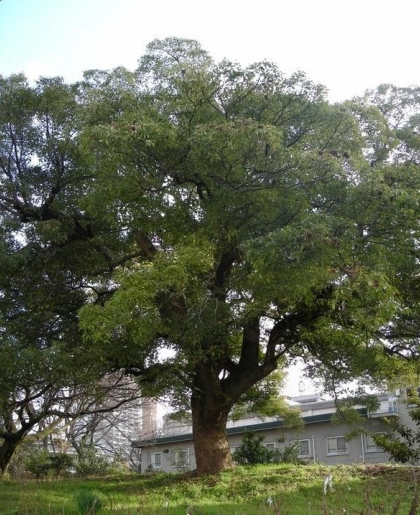
The camphor tree survived the atomic bombing of August 6, 1945.
You cannot enter the premises without permission.
19 Ginkgo Tree
19. Ginkgo Tree (Ginkgo Biloba) 3-3 Teramachi, Naka-ku, Hiroshima-shi
3-3 Teramachi, Naka-ku, Hiroshima-shi
Specie(s):Ginkgo Biloba
Distance from the hypocenter:1120m
Location:Hosenbo Temple


It is said that at the time of the atomic bombing, the large ginkgo tree at Hosenbo Temple in Teramachi prevented the collapsed temple from burning down entirely. (The head priest and three of his family members were killed, however.) The tree itself was terribly burnt but sprouted several years later. After using a temporary hall for many years, the new main hall of the temple was finally constructed in 1994. They did not want to cut the tree, so the ginkgo tree is now standing in a big hole created in the staircase that leads to the main entrance (there are openings for ventilation in the staircase, so the tree would not suffocate). It is said that the temple was originally established in Kabe, to the north of Hiroshima, in the late Kamakura period (1192-1333), but was moved to this area in the late 17th century. All the temples in Teramachi are Jodo Shinshu temples. Jodo Shinshu, meaning True Pure Land School, has prospered in Hiroshima.
Reference: 『歩いて見てほしい ひろしま原爆の木たち』 大川悦生 たかの書 房 1995 年
20 Camphor Tree
20. Camphor Tree (Cinnamomum Camphora) 1 Temmacho, Nishi-ku, Hiroshima-shi
1 Temmacho, Nishi-ku, Hiroshima-shi
Specie(s):Cinnamomum Camphora
Distance from the hypocenter:1140m
Location:On the sidewalk on the southeast side of Tenma Elementary School

The tree had a scar on its trunk until the 1980s, but the scar is not noticeable now. Also, its trunk leans slightly towards the hypocenter.
Reference (Japanese): 被爆樹木リスト Camphor Tree
21 Japanese Sago Palm
21. Japanese Sago Palm (Cycas Revoluta) 1-19 Teramachi, Naka-ku, Hiroshima-shi
1-19 Teramachi, Naka-ku, Hiroshima-shi
Specie(s):Cycas Revoluta
Distance from the hypocenter:1150m
Location:Honganji Hiroshima Betsuin Temple


Located at Hiroshima Betsuin of Nishi Hongaji Temple in Teramachi. The temple was established in 1459, and moved to this place in 1609 by lord Fukushima Masanori. The fern palm was drawn in a picture about 100 years ago. In 1964, when the main hall of the temple was rebuilt after the atomic bombing, the palm tree was moved to its present location beside the belfry. All the temples in Teramachi are Jodo Shinshu temples. Jodo Shinshu, meaning True Pure Land School, has prospered in Hiroshima.
References (Japanese)
22 Plane Trees
22. Plane Trees (Platanus Orientalis) 1-27 Temmacho, Nishi-ku, Hiroshima-shi
1-27 Temmacho, Nishi-ku, Hiroshima-shi
Specie(s):Platanus Orientalis
Distance from the hypocenter:1270m
Location:Tenma Elementary School

There are four A-bombed plane trees at Tenma Elementary School. They were planted in 1931 by the students who were graduating that year. The school buildings were all destroyed by the bomb, and 13 teachers/staff members and 280 students died. Students wrote the words of the song, "Winds Blowing the Plane Trees." The plane trees have become symbols of love and peace and held in affection by students and local people alike. To listen to the song, please visit http://www.tenma-e.edu.city.hiroshima.jp/mupura/puratanasun okazega.htm.
Reference (Japanese)
23 Chinese Parasol Tree
23. Chinese Parasol Tree (Firmiana Simplex) 1 Nakajimacho, Naka-ku, Hiroshima-shi
1 Nakajimacho, Naka-ku, Hiroshima-shi
Specie(s):Firmiana Simplex
Distance from the hypocenter:1300m
Location:Hiroshima Peace Memorial Park
The trees used to be at the courtyard of the Hiroshima Post and Telecommunication Bureau, which was located to the northeast of the castle. They were transplanted to the north side of the memorial museum in the Hiroshima Peace Memorial Park in 1973. The survivors of the atomic bomb were encouraged when the parasol trees had new buds in the spring of 1946. A song of the parasol tree called "Aogiri no Uta" was made by a nine-year old girl in 2001. It can be listened to thanks to an audio system in front of the tree.
Reference: 広島平和記念資料館 Hiroshima Peace Memorial Museum
24 Japanese Black Pine
24. Japanese Black Pine (Pinus Thunbergii) 5-10 Sumiyoshicho, Naka-ku, Hiroshima-shi
5-10 Sumiyoshicho, Naka-ku, Hiroshima-shi
Specie(s):Pinus Thunbergii
Distance from the hypocenter:1300m
Location:Sumiyoshi Shrine


Located at Sumiyoshi Shrine by the Honkawa River. There are two A-bombed black pines. The shrine was established in 1733 and moved to this place in 1799. The building was burned in the atomic bombing, but the pine trees survived. According to the yellow plate, these trees were transplanted to the present locations when the main hall was renovated in 1995.
Reference (Japanese): 被爆樹木リスト Japanese Black Pine
25 Ginkgo Tree, Muku Tree, and Japanese Black Pine
25. Ginkgo Tree, Muku Tree, and Japanese Black Pine (Ginkgo Biloba, Aphananthe Aspera, Pinus Thunbergii) 2-11 Kaminoboricho, Naka-ku, Hiroshima-shi
2-11 Kaminoboricho, Naka-ku, Hiroshima-shi
Specie(s):Ginkgo Biloba, Aphananthe Aspera, Pinus Thunbergii
Distance from the hypocenter:1370m
Location:Shukkeien Garden
Shukkeien Garden was created in 1620 by Ueda Soko (1563-1650) for the lord Asano Nagaakira (1586-1632). Soko, a samurai, was one of the greatest tea masters of that time and the tea school originated by him has continued for 16 generations. There are three A-bombed trees in the garden: a ginkgo, a black pine and a muku. The ginkgo tree is more than 200 years old. It is slanting toward the hypocenter because after the blast moved outward from the city center, the air gushed back in. The trunk of the tree is about 4 meters in circumference and about 17 meters tall. The branches are pruned so that the tree won't fall down. After the atomic bomb, many people fled to this garden and died here. In 1987, about 64 people's remains were excavated and moved to the memorial mound in the Peace Memorial Park. Near the A-bombed black pine, there is a monument erected in 1988 for these victims. The black pine is supported by wire. The muku tree is at the far end of the garden in the northwest corner. It has a big scar but still bears sweet fruits. Open hours: 9:00-18:00 (April-September), 9:00-17:00 (October-March) Admission: 250 yen (adult)
26 Japanese Hackberry
26. Japanese Hackberry (Celtis Sinensis Var. Japonica) 12 Hashimotocho, Naka-ku, Hiroshima-shi
12 Hashimotocho, Naka-ku, Hiroshima-shi
Specie(s):Celtis Sinensis Var. Japonica
Distance from the hypocenter:1400m
Location:Near Kamiyanagi-Bashi Bridge, On the right bank of Kyobashi River

This tree was registered as an A-bombed tree thanks to the person who used to live here and could testify that the tree was in his garden at the time of the atomic bombing.
Reference (Japanese): 被爆樹木リスト Japanese Hackberry
27 Weeping Willow
27. Weeping Willow (Salix Babylonica) 12 Hashimotocho, Naka-ku, Hiroshima-shi
12 Hashimotocho, Naka-ku, Hiroshima-shi
Specie(s):Salix Babylonica
Distance from the hypocenter:1400m
Location:Near Kamiyanagi-Bashi Bridge, On the right bank of Kyobashi River


The relatives of Hara Tamiki (the author of Summer Flowers) used to live here. Based on the testimony of Tamiki's nephew, the willow was registered as an A-bombed tree. There are many stone steps along the riverside. They are called gangi, showing that Hiroshima was a water city, where many boats travelled up and down the river.
There are 11 A-bombed trees in Senda Elementary School. The Ginkgo tree relocated to its current location in the late 1960s. Many other things in the school, such as a Japanese Sago Palm and a stone statue, were also A-bombed. They are all used for peace education.
You cannot enter the school without permission.
Reference (Japanese): 被爆樹木リスト Ginkgo Tree
29 Ginkgo Tree
29. Ginkgo Tree (Ginkgo Biloba) 15-22 Sumiyoshicho, Naka-ku, Hiroshima-shi
15-22 Sumiyoshicho, Naka-ku, Hiroshima-shi
Specie(s):Ginkgo Biloba
Distance from the hypocenter:1420m
Location:Joseiji Temple

When the main hall of the temple was rebuilt in 1981, they created a hole in the staircase for the ginkgo tree.
Reference (Japanese): 被爆樹木リスト Ginkgo Tree
30 Jujube
30. Jujube (Ziziphus Jujuba) 1 Nishikanommachi, Nishi-ku, Hiroshima-shi
1 Nishikanommachi, Nishi-ku, Hiroshima-shi
Specie(s):Ziziphus Jujuba
Distance from the hypocenter:1430m
Location:Peace Boulevard

The jujube has been registered as an A-bombed tree thanks to the information provided by a citizen. The scar on its trunk faces the opposite direction of the hypocenter due to the transplant.
Reference (Japanese): 被爆樹木リスト Jujube
31 Japanese Hackberry
31. Japanese Hackberry (Celtis Sinensis Var. Japonica) 6-29 Kaminoboricho, Naka-ku, Hiroshima-shi
6-29 Kaminoboricho, Naka-ku, Hiroshima-shi
Specie(s):Celtis Sinensis Var. Japonica
Distance from the hypocenter:1440m
Location:Noboricho Junior High School
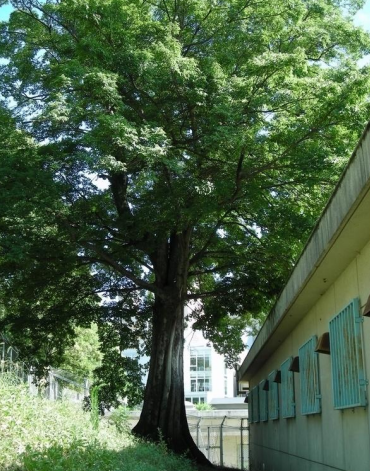

The Japanese hackberry has a deep, big scar on its trunk, which leans towards the hypocenter.
Sadako Sasaki was a student of Noborimachi Junior High School. She died of leukemia ten years after the A-bombing. Her death led to the creation of the Children's Peace Monument in Hiroshima Peace Memorial Park.
Reference (Japanese): 被爆樹木リスト Japanese Hackberry
32 Muku Tree
32. Muku Tree (Aphananthe Aspera) 6-29 Kaminoboricho, Naka-ku, Hiroshima-shi
6-29 Kaminoboricho, Naka-ku, Hiroshima-shi
Specie(s):Aphananthe Aspera
Distance from the hypocenter:1440m
Location:Noboricho Junior High School
The muku tree has a deep scar on the upper part of its trunk.
Sadako Sasaki was a student of Noborimachi Junior High School. She died of leukemia ten years after the A-bombing. Her death led to the creation of the Children's Peace Monument in Hiroshima Peace Memorial Park.
Reference (Japanese): 被爆樹木リスト Muku Tree
33 Japanese Apricot and Others
33. Japanese Apricot and Others (Prunus Mume etc.) 8-8 Higashihakushimacho, Naka-ku, Hiroshima-shi
8-8 Higashihakushimacho, Naka-ku, Hiroshima-shi
Specie(s):Prunus Mume etc.
Distance from the hypocenter:1580m
Location:Tokuoji Temple


On the premises of Tokuo Temple, built in the 17th century, there are a Japanese apricot, a maple tree, a Japanese black pine, a camphor tree, and eight ring-cupped oaks.
The maple tree is the only one of its kind that was A-bombed and is still alive. The bark of the camphor tree is different from the usual ones. However, it is not yet clear whether the difference is attributable to the A-bombing.
Tokuoji Temple was first established in Kishu, today's Wakayama Prefecture, and moved here in the 17th century. The buildings were burned in the atomic bombing and rebuilt after the war.
Reference 1 (Japanese): 被爆樹木リスト Japanese Apricot
Reference 2 (Japanese): 被爆樹木リスト Maple Tree
Reference 3 (Japanese): 被爆樹木リスト Japanese Black Pine
Reference 4 (Japanese): 被爆樹木リスト Camphor Tree
Reference 5 (Japanese): 被爆樹木リスト Ring-Cupped Oak
34 Japanese Sago Palm
34. Japanese Sago Palm (Cycas Revoluta) 10-8 Kyobashicho, Minami-ku, Hiroshima-shi
10-8 Kyobashicho, Minami-ku, Hiroshima-shi
Specie(s):Cycas Revoluta
Distance from the hypocenter:1590m
Location:Senryuji Temple

The aerial part of the Japanese sago palm burned down due to the A-bombing, but surviving roots sprouted later. The tree was separated into two at the time of its relocation to the current location.
Reference (Japanese): 被爆樹木リスト Japanese Sago Palm
35 Chinese Juniper and Others
35. Chinese Juniper and Others (Juniperus Chinensis 'Kaizuka' etc.) 2-1-34 Higashisendamachi, Naka-ku, Hiroshima-shi
2-1-34 Higashisendamachi, Naka-ku, Hiroshima-shi
Specie(s):Juniperus Chinensis 'Kaizuka' etc.
Distance from the hypocenter:1640m
Location:Senda Elementary School


Senda Elementary School was constructed in 1924. Three teachers and 41 students were killed in the atomic bombing. All school buildings burned down, leaving only the bent iron framework of the auditorium.
There are 11 A-bombed trees on the premises of Senda Elementary School, including Chinese junipers, Japanese wisterias, camphor trees, and so on. The junipers and the wisterias were A-bombed in a different place within the school and transplanted to its current location later. The camphor trees have not been transplanted.
You cannot enter the school without permission.
Reference 1 (Japanese): 千田小学校の歴史
Reference 2 (Japanese): 被爆樹木リスト Chinese Juniper
Reference 3 (Japanese): 被爆樹木リスト Japanese Wisteria
Reference 4 (Japanese): 被爆樹木リスト Camphor Tree
36 Weeping Willow
36. Weeping Willow (Salix Babylonica) 20 Hijiyama Hommachi, Minami-ku, Hiroshima-shi,
20 Hijiyama Hommachi, Minami-ku, Hiroshima-shi,
Specie(s):Salix Babylonica
Distance from the hypocenter:1700m
Location:At the eastern foot of Tsurumi Bridge
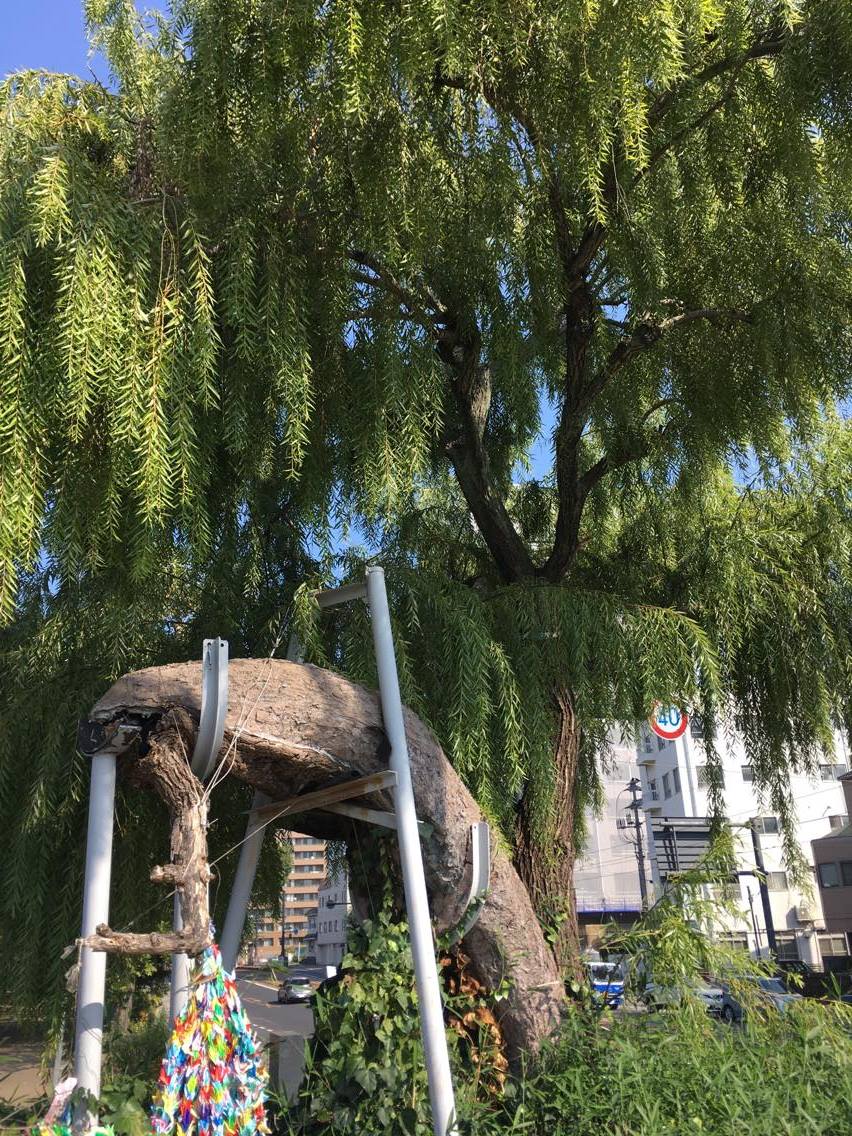

Located at the foot of Tsurumi-bashi Bridge at the eastern end of the Peace Boulevard. "Tsuru" means cranes. Cranes used to fly to Hijiyama Hill, located further east of this bridge, from where people could bird-watch. In 1880, the original wooden bridge was built and named Tsurumi-bashi, meaning "crane watching bridge." The bridge caught fire at the time of the atomic bomb, but people tried to extinguish the fire. Thanks to their efforts, the bridge did not fall, and many survivors fled to Hijiyama Hill crossing it. It was replaced by another wooden bridge in 1957. After a steel pedestrian bridge was constructed near this bridge, the wooden bridge was dismantled in 1974. The current bridge was built in 1990. When it was built, the willow was transplanted to the present location. Its trunk is weak, but a new willow tree from the same root has grown into a big tree. The current bridge won the Civil Engineering Design Prize in 2001.
Reference 1 (Japanese):『河岸の戦後史2 京橋川』広島市博物館資料調査報告書 VI
Reference 2 (Japanese)
37 Japanese Summer Orange Tree
37. Japanese Summer Orange Tree (Citrus Natsudaidai) 23-2 Hakushima Kukencho, Naka-ku, Hiroshima-shi
23-2 Hakushima Kukencho, Naka-ku, Hiroshima-shi
Specie(s):Citrus Natsudaidai
Distance from the hypocenter:1700m
Location:Komyoin Temple


Located at Komyoin Temple near the railway track. There are two summer orange trees. White blossoms bloom in spring. The temple was burned, but the main Buddha (medicine Buddha) had been evacuated to Fudoin Temple. The new temple building was built in 1983.
38 Kurogane Holly
38. Kurogane Holly (Ilex Rotunda) 2-1-26 Kanon Hommachi, Nishi-ku, Hiroshima-shi
2-1-26 Kanon Hommachi, Nishi-ku, Hiroshima-shi
Specie(s):Ilex Rotunda
Distance from the hypocenter:1770m
Location:Kanon Elementary School


Hiroshima Prefectural Second High School was located at this place at the time of the bombing. The first year students were engaged in the so-called demolition work of houses in the city center near the Peace Park of today. Most of them died instantaneously. Orimen Shigeru was one of them. He was 13 years old. His scorched lunch box is exhibited in the memorial museum. The school buildings too were seriously damaged. Seven teachers and 343* students of the high school died in the atomic bombing. In 1950, the school, now called Hiroshima Kanon Senior High School, moved a few hundred meters to the south, and this elementary school opened here in the same year. This tree was donated by a neighbor to the elementary school in 1989 when his family moved out of the area. The tree had a crack from the atomic bombing, and a typhoon broke it into half from the crack.
* According to the website of Hiroshima Kanon Senior High School. See also No.38 Camphor trees.
39 Ginkgo Tree, Japanese Black Pine, and Japanese Sago Palm
39. Ginkgo Tree, Japanese Black Pine, and Japanese Sago Palm (Ginkgo Biloba, Pinus Thunbergii, Cycas Revoluta) 2-6-25 Futabanosato, Higashi-ku, Hiroshima-shi
2-6-25 Futabanosato, Higashi-ku, Hiroshima-shi
Specie(s):Ginkgo Biloba, Pinus Thunbergii, Cycas Revoluta
Distance from the hypocenter:1780m
Location:Myojoin Temple


There are three A-bombed trees in Myojoin Temple near the Kyobashi River. Most of the temple structures were burned down by the atomic bomb. The present temple building was reconstructed in 1974. There are many temples and shrines around here. In Japan, the northeast direction is considered "kimon" (devil's gate), so in order to protect the castle, many temples and shrines were gathered in the northeast direction of the castle by the lords of Hiroshima. Myojoin Temple was one of the largest temples and used to include Hachimangu, today's Tsuruhane Shrine. See also No.41 Ginkgo trees and others.
40 Camphor Tree
40. Camphor Tree (Cinnamomum Camphora) 2-1-26 Kanon Hommachi, Nishi-ku, Hiroshima-shi,
2-1-26 Kanon Hommachi, Nishi-ku, Hiroshima-shi,
Specie(s):Cinnamomum Camphora
Distance from the hypocenter:1800m
Location:Kanon Elementary School


There are four A-bombed camphor trees at the north side of this school. Hiroshima Prefectural Second High School was here at the time of the atomic bombing. The school buildings were heavily destroyed. The number of the victims is unknown, but 322* students who were at the demolition site of buildings near the Peace Park of today died in the atomic bombing, alongside the accompanying teachers. In 1950, the high school moved out, and this elementary school was opened. Permission is required to enter the school, but these trees can be seen from outside.
*According to the signboard at the elementary school. See also No.36 Kurogane holly.
41 Yoshino Cherry
41. Yoshino Cherry (Cerasus × Yedoensis 'Somei-Yoshino') 7-1 Hijiyamacho, Minami-ku, Hiroshima-shi
7-1 Hijiyamacho, Minami-ku, Hiroshima-shi
Specie(s):Cerasus × Yedoensis 'Somei-Yoshino'
Distance from the hypocenter:1800m
Location:Sanyo Buntokuden


There are two A-bombed cherry trees at Sanyo Buntokuden, located near the foot of Hijiyama Hill, next to Tamon-in Temple. Buntokuden was built in 1934 to mark the centennial of Rai Sanyo's death. Rai Sanyo was a famous scholar, and his museum is in the city center. (See No.2 Kurogane holly.) As WWII aggravated, parts of city government functions were moved to Sanyo Buntokuden. After the war, this was used as Asano Library and a social education facility (now closed). On the top of the roof, there is a nine-ring ornament, which was bent due to the atomic bombing. The atomic bomb exploded in Hiroshima at 8:15 a.m. on August 6, 1945. On the evening of August 6, the prefectural air-defense headquarters were moved to Tamon-in at the foot of Hijiyama Hill, although the temple roof was severely damaged. On August 7, the headquarters were moved again to the East Police Station, but the temple was used to receive relief goods and arrange distributing rice balls to the survivors who had fled to Hijiyama Hill. Many survivors were also given first-aid treatment there. The belfry is one of the existing A-bombed buildings.
Reference: 『被爆 50 周年 ヒロシマの被爆建造物は語る―未来への記録』 広島 市 1996
42 Yoshino Cherry and Tabunoki
42. Yoshino Cherry and Tabunoki (Cerasus × Yedoensis 'Somei-Yoshino', Machilus Thunbergii) 7-1 Hijiyamacho, Minami-ku, Hiroshima-shi
7-1 Hijiyamacho, Minami-ku, Hiroshima-shi
Specie(s):Cerasus × Yedoensis 'Somei-Yoshino', Machilus Thunbergii
Distance from the hypocenter:1800m
Location:Ikari Shrine


Located at Ikari Shrine in Hakushima. This is one of the oldest shinto shrines in Hiroshima. These trees were burned by the atomic bomb, but they later sprouted from the roots. The shrine was completely burned but reconstructed in 1965. "Ikari" means anchor. The name of the shrine was derived from the fact that many ships anchored here and prayed for safe navigation. The area of Hakushima was an island called "Hakoshima" until the 16th century.
Reference: 『二葉の里歴史の散歩道~歴史と平和 緑と安らぎ~』 広島市東区
43 Japanese Black Pine, Ginkgo Tree, and Camphor Tree
43. Japanese Black Pine, Ginkgo Tree, and Camphor Tree (Pinus Thunbergii, Ginkgo Biloba, Cinnamomum Camphora) 2-5-11 Futabanosato, Higashi-ku, Hiroshima-shi
2-5-11 Futabanosato, Higashi-ku, Hiroshima-shi
Specie(s):Pinus Thunbergii, Ginkgo Biloba, Cinnamomum Camphora
Distance from the hypocenter:1810m
Location:Tsuruhane Shrine
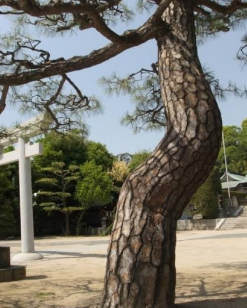

Located at Tsuruhane Shrine next to Myojoin Temple near the Kyobashi River. The shrine has a history of more than 800 years. It was moved to its present location in the 19th century. The name of the shrine was changed to Tsuruhane Shrine in 1872 because the hill behind the shrine looks like a crane ("tsuru") stretching its wings ("hane"). See also No.37 Ginkgo tree and others.
44 Bodaiju and Camellia
44. Bodaiju and Camellia (Tilia Miqueliana, Camellia Japonica Cv.) 12-4 Hakushima-kukencho, Naka-ku, Hiroshima
12-4 Hakushima-kukencho, Naka-ku, Hiroshima
Specie(s):Tilia Miqueliana, Camellia Japonica Cv.
Distance from the hypocenter:1820m
Location:Hoshoin Temple
Located at Hoshoin Temple next to Ikari Shrine. The camellia was about 10 meters tall and a symbol of the community. It was burned but sprouted again from the stump. There is a scorched scar at the bottom of the tree. A second-generation Bohdi tree was planted at Hakushima Elementary School to celebrate the centennial of the school in 1973. Hoshoin Temple was established at this location in 1598, after Mori Terumoto moved to Hiroshima Castle. The temple was located in the northeast direction (the bad luck direction called kimon) to protect the castle. Hoshoin Temple and Ikari Shrine were one temple/shrine complex but were separated in 1868. After the atomic bombing, the main hall was rebuilt in 1949, and again in 1974, when the trees were relocated to the present locations.
Reference: 『開創四百年記念誌』 真言宗寶勝院 1998 年
45 Camphor Tree, Japanese Flowering Apricot*, and Camellias*
45. Camphor Tree, Japanese Flowering Apricot*, and Camellias* (Cinnamomum Camphora) 1-9-25 Misasamachi, Nishi-ku, Hiroshima-shi
1-9-25 Misasamachi, Nishi-ku, Hiroshima-shi
Specie(s):Cinnamomum Camphora
Distance from the hypocenter:1850m
Location:Misasa Elementary School
Located at Misasa Elementary School. The A-bombed camphor tree was transplanted to this elementary school from a private house on the north side of the Japan Electric Meters Inspection Corporation in 1954. It is in beautiful triangular shape. The apricot and the two camellia trees (one with red blossoms with white spots, and the other with pink blossoms) were donated later to the school and registered as A-bombed trees in 2009.
- Updated November 2019: GLH too has now marked out these trees—the Camelias, and the Japanese Flowering Apricot died in 2015.
* indicates that the tree has been removed from the Hibaku Jumoku list by the Hiroshima City.
46 Camphor Tree and Japanese Quince
46. Camphor Tree and Japanese Quince (Camphor Tree, Chaenomeles Speciosa) 1-11-5 Misasamachi, Nishi-ku, Hiroshima-shi
1-11-5 Misasamachi, Nishi-ku, Hiroshima-shi
Specie(s):Camphor Tree, Chaenomeles Speciosa
Distance from the hypocenter:1850m
Location:Misasa Shrine


The A-bombed camphor tree was donated to this shrine by the same person who gave an A-bombed camphor tree to Misasa Elementary School. The leaves of this tree are larger than ordinary camphor leaves. The quince blooms in spring and bears fruit by summer. The shrine was established in the 16th century. It was moved here in 1654.
47 Camphor Tree
47. Camphor Tree (Cinnamomum Camphora) 1-6-9 Misasamachi, Nishi-ku, Hiroshima-shi
1-6-9 Misasamachi, Nishi-ku, Hiroshima-shi
Specie(s):Cinnamomum Camphora
Distance from the hypocenter:1870m
Location:Koryuji Temple


The tree burned down due to the A-bombing but sprouted later. Today, there are three trunks from the same roots. The temple burned down because of the bombing. The main hall was rebuilt in 1960.
Reference (Japanese): 被爆樹木リスト Camphor Tree
48 Japanese Sago Palm
48. Japanese Sago Palm (Cycas Revoluta) 5-10 Hakushima Kukencho, Naka-ku, Hiroshima-shi
5-10 Hakushima Kukencho, Naka-ku, Hiroshima-shi
Specie(s):Cycas Revoluta
Distance from the hypocenter:1880m
Location:Singyouji Temple


The tree was at another location at the time of the A-bombing but relocated to its current location later.
Reference (Japanese): 被爆樹木リスト Japanese Sago Palm
49 Chinese Juniper
49. Chinese Juniper (Juniperus Chinensis 'Kaizuka') 1-18 Fukushimacho, Nishi-ku, Hiroshima-shi
1-18 Fukushimacho, Nishi-ku, Hiroshima-shi
Specie(s):Juniperus Chinensis 'Kaizuka'
Distance from the hypocenter:1900m
Location:On the sidewalk on the east side of Fukushima Nursery School


Before the war, there was a complex of facilities in the area around the nursery school. After the redevelopment of the area, the tree was relocated to the current location.
Reference (Japanese): 被爆樹木リスト Chinese Juniper
50 Japanese Black Pine
50. Japanese Black Pine (Pinus Thunbergii) 2-6-3 Dambara, Minami-ku, Hiroshima-shi
2-6-3 Dambara, Minami-ku, Hiroshima-shi
Specie(s):Pinus Thunbergii
Distance from the hypocenter:1900m
Location:Myosenji Temple

Myosenji Temple is located on the north side of Hijiyama Hill in Danbara. This pine tree and the temple gate survived the atomic bombing. They were transplanted to the current location at the time of the redevelopment of this area in 1995.
Reference (Japanese):『被爆 50 周年 ヒロシマの被爆建造物は語る―未来への記録』広島市 1996年
51 Camphor Tree
51. Camphor Tree (Cinnamomum Camphora) 3 Hijiyama Koen, Minami-ku, Hiroshima-shi
3 Hijiyama Koen, Minami-ku, Hiroshima-shi
Specie(s):Cinnamomum Camphora
Distance from the hypocenter:1950m
Location:Hijiyama Park
A Hibakusha's testimony led to the registration of the tree as A-bombed tree. (The person said that the tree was there before the war as well as when the person was evacuating.)
Reference (Japanese): 被爆樹木リスト Camphor Tree
52 Camphor Tree
52. Camphor Tree (Cinnamomum Camphora) 3-7 Sendamachi, Naka-ku, Hiroshima-shi
3-7 Sendamachi, Naka-ku, Hiroshima-shi
Specie(s):Cinnamomum Camphora
Distance from the hypocenter:2030m
Location:Senda Park


There are 22 A-bombed camphor trees there. The Hiroshima Technical College, formerly called the Hiroshima Higher Technical School, was located here. In 1949, the school and Hiroshima Municipal Higher Technical School were combined to establish the Faculty of Engineering of Hiroshima University. Hiroshima Prefectural Technical High School was located on the west side of the park. In 1953, it moved to Deshio, the present location of the high school. Senda Park was made after Hiroshima University's Faculty of Engineering was moved to the current locations in Higashi Hiroshima in 1982.
Reference 1 (Japanese):『広島原爆戦災誌 第四巻』広島市 1971年
Reference 2 (Japanese)
53 Camphor Tree
53. Camphor Tree (Cinnamomum Camphora) 3-2 Futabanosato, Higashi-ku, Hiroshima-shi
3-2 Futabanosato, Higashi-ku, Hiroshima-shi
Specie(s):Cinnamomum Camphora
Distance from the hypocenter:2040m
Location:Futabanosato Daini Park
A citizen's testimony led to the registration of the tree as A-bombed tree.
There used to be a military facility in the area around the park. The facility acted as a first-aid station after the A-bombing.
Reference (Japanese): 被爆樹木リスト Camphor Tree
54 Camphor Tree
54. Camphor Tree (Cinnamomum Camphora) 19 Hakushima Kitamachi, Naka-ku, Hiroshima-shi
19 Hakushima Kitamachi, Naka-ku, Hiroshima-shi
Specie(s):Cinnamomum Camphora
Distance from the hypocenter:2100m
Location:On the east side of Hiroshima Prefectural Culture and Arts Hall (Ueno Gakuen Hall)


There are a line of camphor trees (12 trees in total) on the east side of the Hiroshima Prefectural Culture and Arts Hall. They all relocated to their current location in 1994.
Reference (Japanese): 被爆樹木リスト Camphor Tree
55 Weeping Willow
55. Weeping Willow (Salix Babylonica) 1-10 Ushita Hommachi, Higashi-ku, Hiroshima-shi
1-10 Ushita Hommachi, Higashi-ku, Hiroshima-shi
Specie(s):Salix Babylonica
Distance from the hypocenter:2050m
Location:At the west end of the Futamata Bridge
The weeping willow is about five meters high. Children used to climb the tree to catch cicadas before the A-bombing.
Reference (Japanese): 被爆樹木リスト Weeping Willow
56 Yoshino Cherry and Japanese Black Pine
56. Yoshino Cherry and Japanese Black Pine (Cerasus × Yedoensis 'Somei-Yoshino', Pinus Thunbergii) 1-42 Hakushima Kitamachi, Naka-ku, Hiroshima-shi
1-42 Hakushima Kitamachi, Naka-ku, Hiroshima-shi
Specie(s):Cerasus × Yedoensis 'Somei-Yoshino', Pinus Thunbergii
Distance from the hypocenter:2110m
Location:Yasuda Girls' Junior and Senior High School


The trunk of the yoshino cherry leans towards the hypocenter, just like the ones of other A-bombed trees that have not been transplanted.
The five Japanese black pines in the school have scars on their trunks, made by tapping pitch to produce aviation fuel during the war.
You cannot enter the school without permission.
Reference 1 (Japanese): 被爆樹木リスト Yoshino Cherry
Reference 2 (Japanese): 被爆樹木リスト Japanese Black Pine
57 Weeping Willow
57. Weeping Willow (Salix Babylonica) 1-15-32 Minamimachi, Minami-ku, Hiroshima-shi
1-15-32 Minamimachi, Minami-ku, Hiroshima-shi
Specie(s):Salix Babylonica
Distance from the hypocenter:2160m
Location:Minami Elementary School
The tree has a big scar on its trunk made by the A-bombing. The whiteboard beside the tree says, "The tree teaches us the power and sanctity of life."
The elementary school was established in 1920. Almost all of the school buildings were destroyed by the A-bombing.
You cannot enter the school without permission.
Reference (Japanese): 被爆樹木リスト Weeping Willow
A hole is made in the temple gate to allow the ginkgo tree to grow. The ginkgo is a male tree, so the tree does not bear any ginkgo nuts. There are charred parts high up in the trunk. Anrakuji Temple was built here in 1533. It was burned down in 1758 but rebuilt in 1788. The temple was damaged by A-bombing. The main hall is one of the A-bombed buildings. It was restored in 1994 but still slants to the north from the blast of the atomic bomb. The ginkgo tree saved the temple from being burned down.
Reference (Japanese):『被爆 50 周年 ヒロシマの被爆建造物は語る―未来への記録』 広島市 1996年
59 Camellia and Others
59. Camellia and Others (Camellia Japonica, etc.) 1-8-6 Yoshijima Nishi, Naka-ku, Hiroshima-shi
1-8-6 Yoshijima Nishi, Naka-ku, Hiroshima-shi
Specie(s):Camellia Japonica, etc.
Distance from the hypocenter:2160m
Location:Yoshijima Inari Shrine

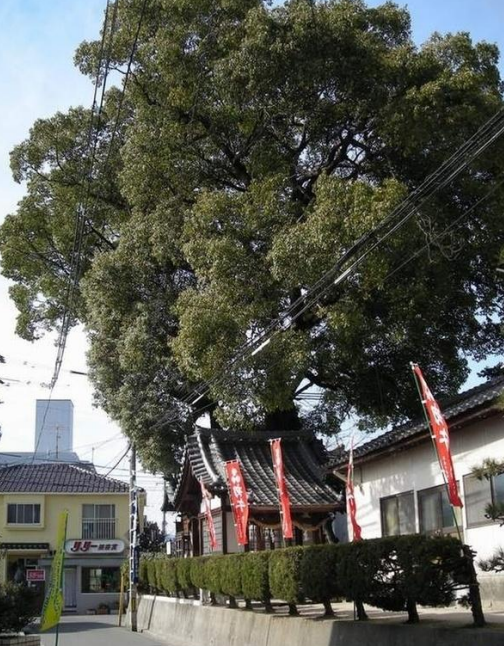
60 Ring-Cupped Oak
60. Ring-Cupped Oak (Quercus Glauca) 1-5-39 Honkawacho, Naka-ku, Hiroshima-shi
1-5-39 Honkawacho, Naka-ku, Hiroshima-shi
Specie(s):Quercus Glauca
Distance from the hypocenter:2180m
Location:Honkawa Elementary School
The tree was A-bombed in a private house and leans toward the opposite direction of the hypocenter. It relocated to its current location in 2012.
You cannot enter the school without permission.
Reference (Japanese): 被爆樹木リスト Ring-Cupped Oak
61 Crinum Lily
61. Crinum Lily (Crinum Latifolium) 1 Nakajimacho, Naka-ku, Hiroshima-shi
1 Nakajimacho, Naka-ku, Hiroshima-shi
Specie(s):Crinum Latifolium
Distance from the hypocenter:2200m
Location:Hiroshima Peace Memorial Park
The crinum lilies were A-bombed in Danbara, located 2200 meters away from the hypocenter, and burned down. However, they sprouted later. A former soldier found the trees one month after the A-bombing and kept them at his home in Kamakura. The soldier donated some of them to the Hiroshima Peace Memorial Park in 1969.
Reference (Japanese): 被爆樹木リスト Crinum Lily
62 Japanese Hackberry
62. Japanese Hackberry (Celtis Sinensis Var. Japonica) 2-1-34 Higashisendamachi, Naka-ku, Hiroshima-shi
2-1-34 Higashisendamachi, Naka-ku, Hiroshima-shi
Specie(s):Celtis Sinensis Var. Japonica
Location:Senda Elementary School
There are 11 A-bombed trees in the school. The Japanese hackberry was A-bombed in a private house and transplanted to its current location in around 1948. In addition to the A-bombed trees, there are also A-bombed things in the school, including a stone statue. Such things relating to the bombing are used for peace education.
You cannot enter the school without permission.
※The distance from the hypocenter is unknown.
Reference (Japanese): 被爆樹木リスト Japanese Hackberry
Tree not found
Enter the name of the tree or the location
delacruzfitain1956.blogspot.com
Source: https://glh.unitar.org/en/trees-in-hiroshima/
0 Response to "How Did the Wind Continue to Haras People in Asano Park"
Post a Comment